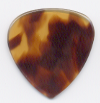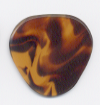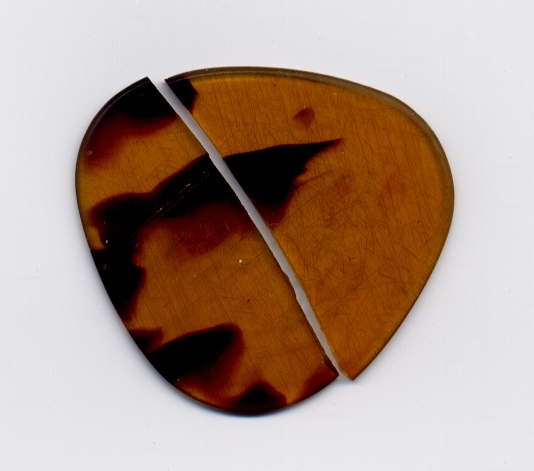"New Tortis" Flat Picks

We offer the seven styles shown above.
 In the mid-to-late 19th century there was a high demand for items made from the shell of the sea-going Hawksbill Turtle. It's shell had properties that made it very desirable to the touch. It was warm and comfortable. It just plain "felt good" to handle. That's why so many items made from it were items that were held close to the body. Ladies' hair combs, knitting needles and fountain pens were but a few of these items made from the shell of the hawksbill turtle. The problem was that the shell material was difficult to come by and therefore very expensive. An alternative was sought out. A new material was formulated from a dairy by-product and this new material fit the bill very nicely
In the mid-to-late 19th century there was a high demand for items made from the shell of the sea-going Hawksbill Turtle. It's shell had properties that made it very desirable to the touch. It was warm and comfortable. It just plain "felt good" to handle. That's why so many items made from it were items that were held close to the body. Ladies' hair combs, knitting needles and fountain pens were but a few of these items made from the shell of the hawksbill turtle. The problem was that the shell material was difficult to come by and therefore very expensive. An alternative was sought out. A new material was formulated from a dairy by-product and this new material fit the bill very nicely
For almost 40 years John Greven has toiled to find the perfect substitute for tortoise shell picks. He has finally found it in this material. This is different than the material he uses for his pick guards, or for the picks he once made. This material is a polymerized animal protein that is very close chemically to real turtle shell. You could look at it as cultured turtle-shell. Many people who have tried picks made from this material cannot tell them apart from the real thing.
Since John is so very busy building his fine guitars, we have taken over his pick-making business. Neither he nor his company, "Turtle-Works" are making these picks. They make pickguards. Red Bear Trading Company is the sole manufacturer of these picks. We call this material "New Tortis" to distinguish it from the Tor-Tis that is used for pick guards.
Gauges:
Light:= 1 - 1.15mm, Medium= 1.16-1.25mm, Heavy= 1.26 - 1.5mm
Note: If you are a heavy-handed picker, then use our medium or heavy gauges of picks. The lights work great if you are playing solo, or with a group in a quieter setting. If you get into a flatpickin' frenzy (and who doesn't every now and again), a light-gauge pick could very well break.
 |
Style "A", available in light, medium and heavy gauge and with our Speed Bevel or our standard bevel which is a knife-edge type of bevel. |
 |
Style "B", available in light, medium and heavy gauge and with our Speed Bevel or our standard bevel which is a knife-edge type of bevel. |
 |
Style "C", available in light, medium and heavy gauge and with our Speed Bevel or our standard bevel which is a knife-edge type of bevel. The "C" Style is also available as our "Gypsy Jazzer" which is 2.5mm thick for the "Django" style players. |
 |
Style "D", available in light, medium and heavy gauge and with our Speed Bevel or our standard bevel which is a knife-edge type of bevel. |
 |
Style "E", available in light, medium and heavy gauge and with our Speed Bevel or a rounded edge bevel, which is standard for this style. |
 |
"Tri-tip", available in light, medium and heavy gauge. This pick has three differently shaped tips. The pointed tip has the Speed Bevel by default. The smaller rounded tip has our standard bevel and the larger rounded tip has a rounded edge bevel. |
 |
"Mondo", available in medium and heavy gauge and with our Speed Bevel or a rounded edge bevel. |
First off - let me say that I do not make the material that these picks are produced from. That process is so highly technical and actually quite dangerous that I could never do it in my shop. That said, I make each pick by hand. There is no CNC process involved at all in the production of the picks. However, I did use CNC to make some of the tools that I use to make the picks. I use a variety of sanders, abrasive sticks (fingernail files) and buffers to produce the final product. In a good day I can make about 30 picks from start to finish. I work alone, so if I take time off, picks don't get made.
Some folks are "pickier" than others when it comes to the edges of their picks. We ship picks with either a rounded edge or a sharply beveled edge depending on the style. If you prefer a rounded edge to a pick that we make with a sharp bevel, it is easy to modify. The picks sand easily so you can sand them to your own preferred shape or edge contour using 320 grit paper or emory board. A thicker pick with a sharper bevel will result in a brighter tone and more pick control and will allow more speed than a thin pick. If you need to restore the glossy finish to your New Tortis pick, use a buffer with brown tripoli compound. When I make them, after the tripoli, I touch them on a wheel with some super-fine yellow compound which is used mainly for plastics. This gives them a "wet" look. If you don't have access to a buffer, a jeweler can buff them for you. You can also purchase fingernail buffing boards at your local K-Mart or similar store. Any tools that work for fingernails work on these picks.
While these picks do indeed sand easily, they exhibit virtually no wear at all - even after several months of daily use. Maybe after years they would, but we will have to wait and see.
CARING FOR YOUR NEW TORTIS PICK
Your New Tortis pick is very similar to real turtle shell so it must be treated as such. Store your pick in your guitar's pick compartment. DO NOT store it in your wallet or carry it around with you in your pocket with metal objects. If you also carry coins, keys etc. in there, your pick will get scratched and may break. In your wallet, it is doomed to failure. The picks are brittle and if flexed will most likely break.
Also, don't let your pick go through the washer and/or dryer in one of your pants pockets (see above warning). The material is hygroscopic (absorbs water) and as such it will most likely deform if allowed to soak in water. Keep your pick dry and clean when not in use. Wipe it off during play time and do so often. I like to rub it on my pant leg between tunes. This keeps it clean and ready.

~
Mandolins & More~
Walton, KY 41094
Please call or
email for an appointment.
So you can experience the instruments
and receive personal attention without interruption.
In other
words...
You'll essentially have the shop all to yourself.
Jeff Cowherd
Phone: (859) 363-1026
Copyright 1999-2008 by Jeff Cowherd. All Rights Reserved